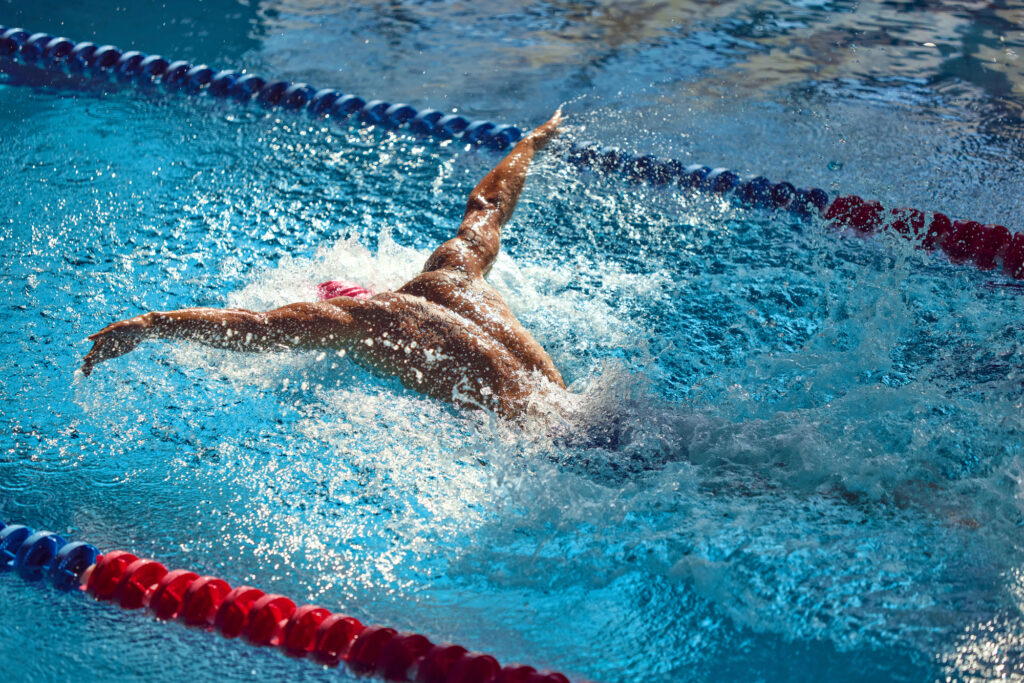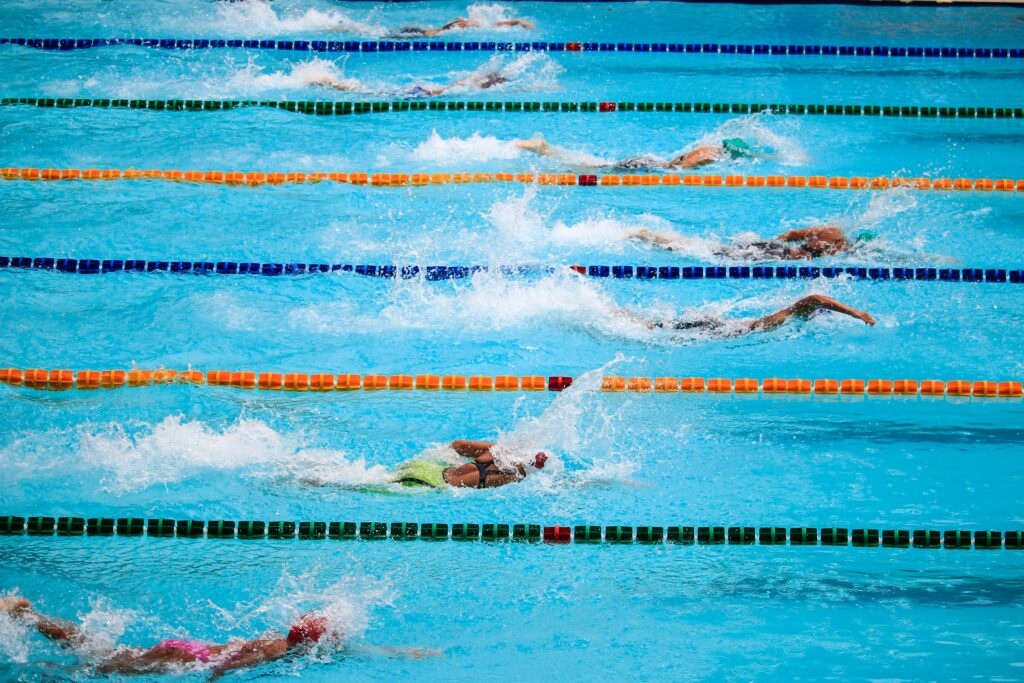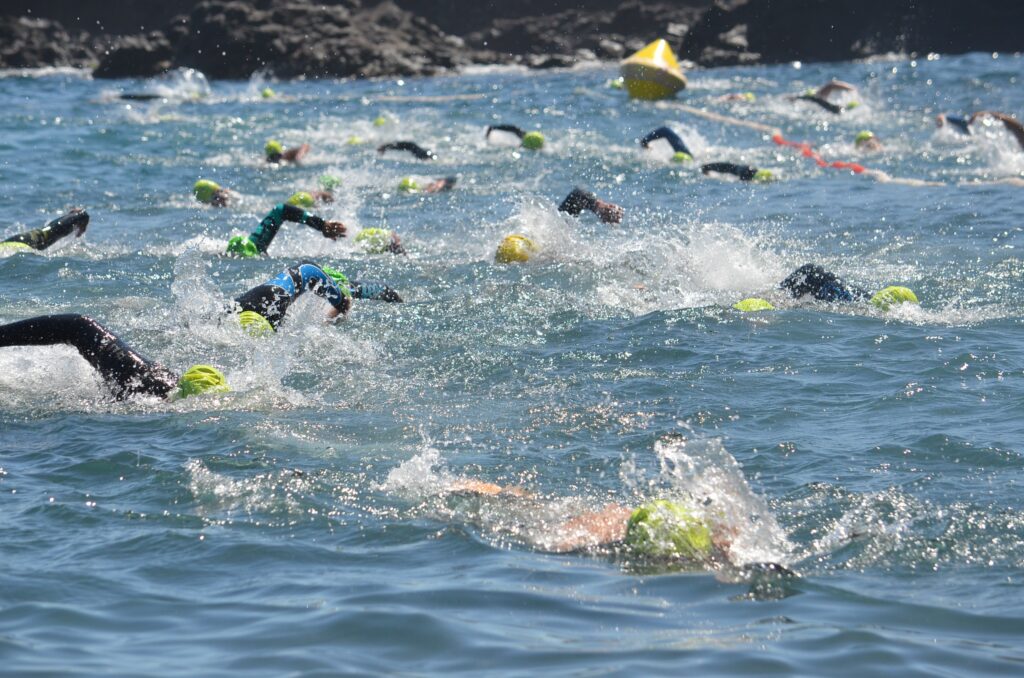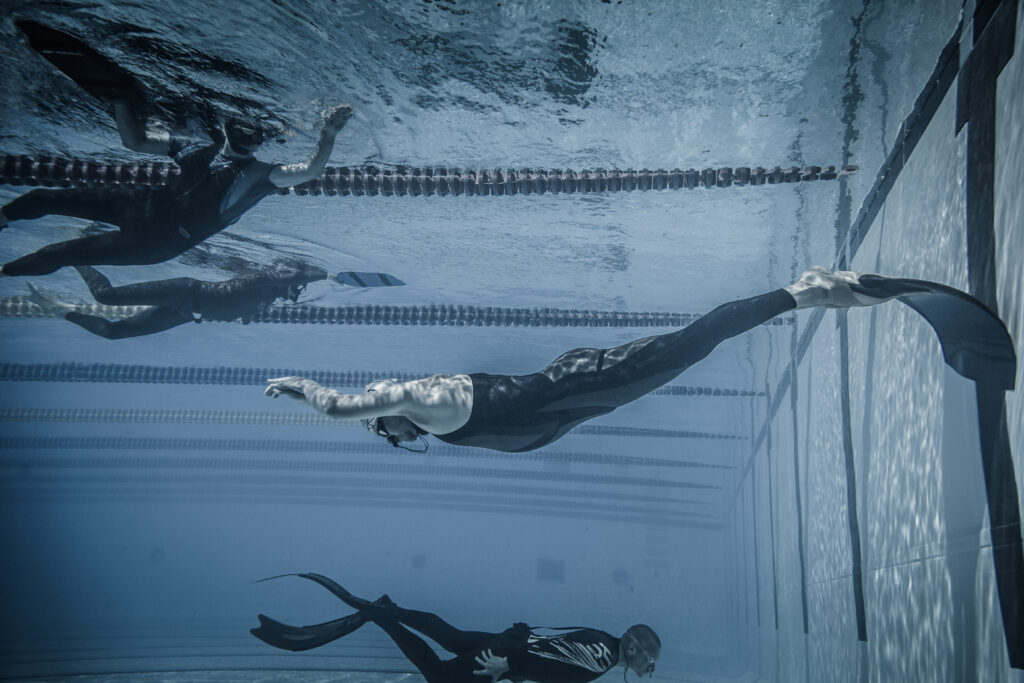Optimising breathing during a butterfly swimming race is crucial for maintaining speed and endurance, particularly in events such as the 100 and 200 metres. In the shorter 100-metre butterfly, swimmers typically aim for a balance between oxygen intake and minimising disruptions in their stroke rhythm. Elite swimmers often adopt a breathing pattern that allows for a breath every other stroke, assisting in maintaining a high tempo and ensuring adequate oxygenation throughout the sprint.
In contrast, the 200-metre butterfly requires a more strategic approach to breathing due to its increased distance and demand for sustained energy output. Swimmers may opt for a breathing pattern that provides sufficient oxygen for both anaerobic and aerobic energy systems, which are taxed during this longer event. A common strategy involves breathing every stroke during the first half of the race to build an oxygen reserve, followed by a more controlled pattern in the second half to conserve energy and focus on technique.
Developing the optimal breathing pattern for both distances comes down to individual preferences and physiological considerations. It’s about finding a rhythm that complements the swimmer’s technique and energy management, ensuring they can maintain a strong pace throughout the race. Coaches and swimmers invest considerable time in training to fine-tune these patterns, often tailoring them to the swimmer’s specific strengths and weaknesses.
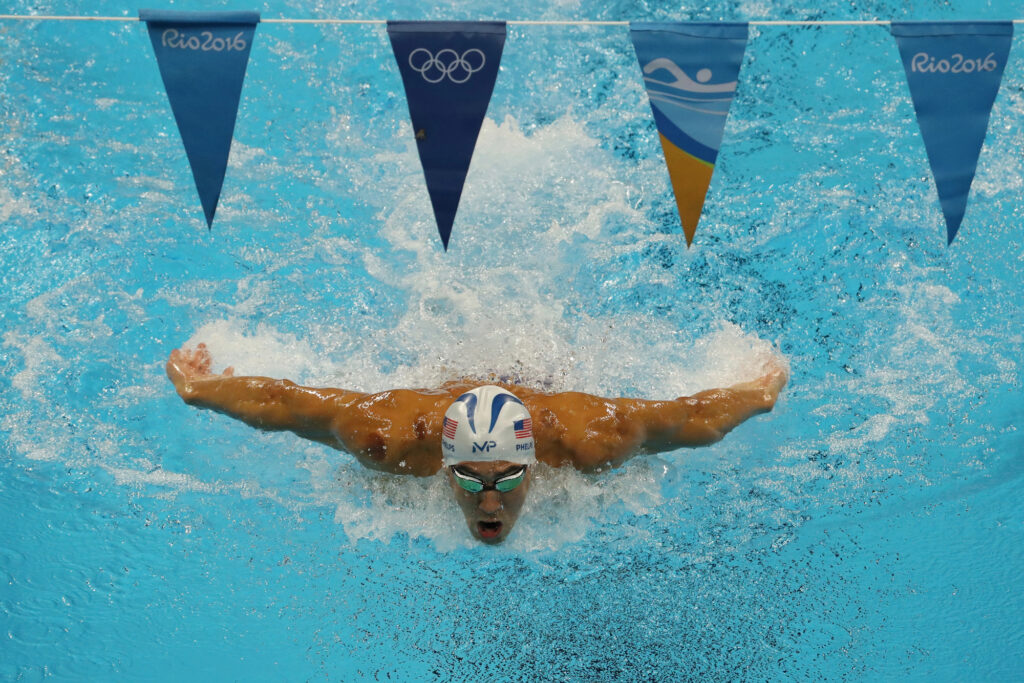
Historical Context
The history of the butterfly stroke and the swimmers who mastered it are pivotal to understanding its current application in competitive races.
Evolution of Butterfly Stroke
The butterfly stroke has undergone significant changes since its inception. Originally developed in the 1930s, Sydney Cavill is credited with innovating the technique by utilising an over-water recovery of the arms, vastly progressing from the traditional breaststroke methods that were previously used. This early style laid the foundation for the modern butterfly stroke, which eventually gained its own distinction as an independent stroke by the time of the 1956 Olympics.
Notable Swimmers and Achievements
Michael Phelps, under the guidance of coach Bob Bowman, has been an influential figure in the butterfly events, setting numerous world records and earning Olympic medals that underscore the evolution of the stroke’s effectiveness. Similarly, Caeleb Dressel has made a significant impact in the 100m butterfly, showcasing the epitome of optimal performance in the stroke. On the women’s side, Sarah Sjöström has set benchmarks with her world record times, becoming an iconic swimmer in the butterfly category, reflecting advancements in training and technique.
Essential Butterfly Technique
Mastering the butterfly stroke demands proficiency in several key areas: the breathing technique, arm movement and pull, leg movement and kick, and the overall body position and undulation. Each component plays a crucial role in maximising performance and efficiency in the water.
Breathing Technique
In butterfly, breathing is synchronised with the arm movements, typically occurring every second or third stroke to maintain rhythm and reduce drag. A swimmer should aim to keep their head low to the water surface, exhaling underwater and inhaling quickly during the arm recovery phase. According to SwimCompetitive, the side breathing butterfly technique, though less common nowadays, used to be favoured for its potential to maintain a higher tempo.
Arm Movement and Pull
The arms in butterfly stroke should move simultaneously with an early vertical forearm to catch the water efficiently. This pull phase starts with the hands entering the water above the head, then pushing down and out in a circular motion. Emphasising the importance of power and technique, the MySwimPro resource suggests maintaining a stronger pull in shorter races like the 100m to optimise propulsion.
Leg Movement and Kick
A swimmer’s legs perform a fluid, butterfly kick, with both feet joined together, kicking downward twice per arm cycle. Crucial for propelling the body forward, the kick’s effectiveness relies on the flexibility of the ankles and the power generated by the hips. It’s a continuous undulation that originates from the core, moving through the body to the legs.
Body Position and Undulation
The quintessential body position for butterfly includes maintaining a streamlined form with slight undulation, promoting efficient forward motion. As each swim movement in butterfly is a composite of well-coordinated actions, it’s vital to master the undulating body movement, reminiscent of a dolphin’s natural propulsion in water.
Consistent practice of these techniques is essential for competitive swimmers aiming to minimise resistance and maximise speed during butterfly events.
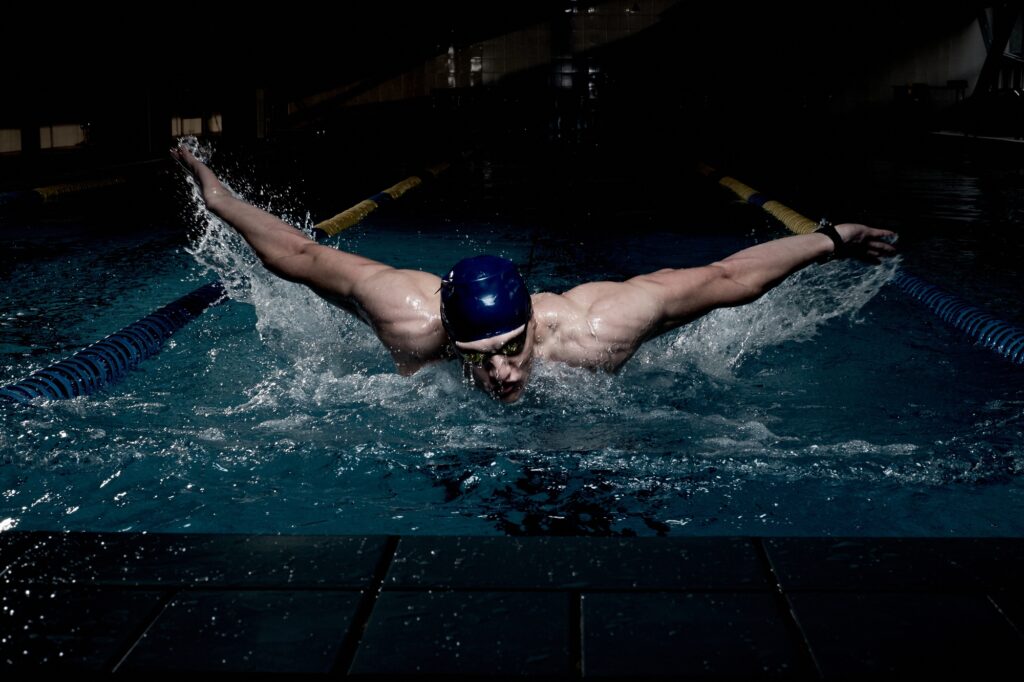
Training and Conditioning
To excel in the butterfly event, swimmers must hone their energy systems, engage in race-specific sets, perform targeted dryland exercises, and implement effective recovery strategies.
Energy Systems Used in Butterfly
In butterfly events, swimmers utilise both aerobic and anaerobic energy systems. The anaerobic system is predominant in short, intense bursts of activity, providing energy for quick, explosive movements through ATP without the need for oxygen. As a 100m butterfly race typically lasts under a minute, this energy system is heavily relied upon. For the longer 200m event, the aerobic system gains importance, demanding a steady supply of oxygen to sustain effort and delay fatigue.
Race-Specific Swim Sets
When practising for the 100m butterfly, swimmers should focus on speed and power with sets like 8×50m at race pace, with a focus on maintaining stroke rate and speed. For the 200m butterfly, sets should target endurance and pace sustainability, such as 4×100m at race pace with sufficient rest to maintain quality. Incorporating drills that replicate the late stages of a race can help swimmers manage the physiological demands of the event. An example set pulled from competitive insights might look like this:
- Early season: 4×(4×50m pace on 1:30 + 200m recovery on 3:30)
- Mid season: 3×(6×50m pace on 1:15 + 200m recovery on 3:30)
Dryland Drills and Exercises
Off the pool, dryland training is crucial for enhancing swimming performance. Swimmers should include strength training, targeting key muscle groups used in butterfly such as the deltoids, lats, and core. Plyometric exercises like box jumps and medicine ball throws develop the power needed for explosive starts and turns. Flexibility training with dynamic stretching can also improve stroke efficiency and help prevent injuries.
Recovery Strategies
Effective recovery is essential for optimal performance in both the 100m and 200m butterfly. Swimmers should adopt recovery strategies like active rest, ensuring low-intensity swimming to flush out lactic acid and promote muscle recovery. Adequate nutrition and hydration are also vital, as is employing restorative techniques such as foam rolling and massage to alleviate muscle soreness and enhance overall recovery. Quality sleep supports these efforts by allowing the body to repair and build muscle.
Incorporating these focused training and conditioning strategies will prepare swimmers to compete at their highest level in butterfly events, whether sprinting a 100m or pacing through a 200m race. It is the synergy of these elements – energy system development, in-pool sets, dryland training, and recovery practices – that shapes a well-rounded and race-ready butterfly swimmer.
The Butterfly Racing Strategy
In the high-velocity world of competitive swimming, a well-honed butterfly racing strategy is crucial for swimmers to achieve peak performance in 100m and 200m races. Precise breathing patterns, well-timed pacing, and efficient turns with underwater phases are the cornerstone techniques that can lead to success.
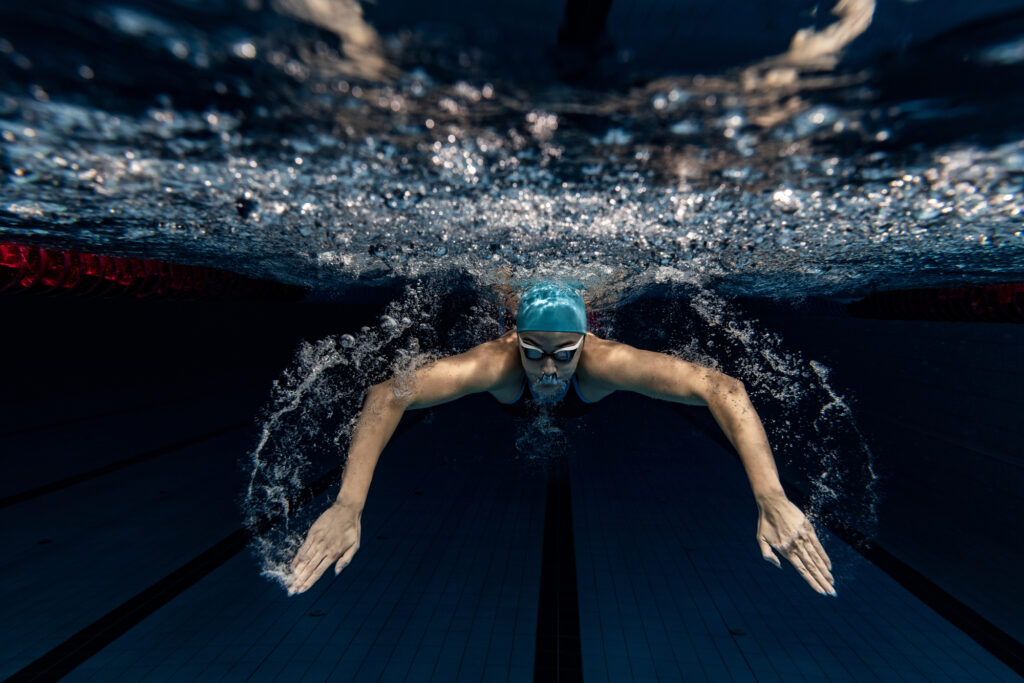
Breathing Patterns for 100m and 200m Races
Swimmers often adopt different breathing patterns when competing in the 100m butterfly compared to the 200m butterfly. For the shorter sprint, one may find a swimmer opting for a breath every second stroke to maintain higher speed and reduce drag. In contrast, during the 200 butterfly, breathing every stroke is common to ensure ample oxygen intake for sustained energy output. Technique guidance stresses the importance of timing the breath as the hands pass the shoulders during the pull phase to optimise airflow without disrupting the stroke’s rhythm.
Pacing the Butterfly Sprint
Pacing plays a pivotal role in managing the swimmer’s energy reserves. In the 100m event, the racer starts at maximum speed, sustaining near-top velocity while balancing on the fine edge of fatigue. For the 200m race, a more strategic approach is adopted, with the first half often swum at a controlled pace, conserving energy before pushing harder in the final lengths. Turn efficiency and the number of underwater dolphin kicks have a substantial impact on the swimmer’s velocity and timing throughout the race.
Turns and Underwater Phases
A butterfly race comprises more than just the swim; each turn can be a make-or-break moment. Swimmers practise touching the wall with two hands and swiftly executing a somersault to minimise time spent in transition. The underwater dolphin kick has emerged as a powerful tool – it is where races can be won or lost. Swimmers must maximise the 15-metre allowance beneath the surface, where water resistance is less compared to above-the-surface swimming, resulting in greater potential for speed before breaking into the stroke.
Technical Skills Optimization
To excel in the 100m and 200m butterfly events, a swimmer must refine their stroke mechanics and ensure they are executing the most efficient movements through the water.
Perfecting the Stroke Technique
In butterfly swimming, perfecting the stroke technique is paramount for maintaining speed and reducing fatigue. Swimmers must focus on the symmetry of their arm movements to ensure an even catch and pulling phase. It’s during the catch phase where they should aim to grab as much water as possible, setting the stage for potent propulsion.
Minimizing Drag and Maximizing Propulsion
Minimizing drag is crucial in improving stroke efficiency. A swimmer must maintain a neutral position with a streamlined body to glide through the water with minimal resistance. This involves keeping the head down during the recovery phase and timing breaths to avoid disrupting momentum. Simultaneously, maximizing propulsion is achieved through powerful kicks and a strong pulling motion that complements each pull.
Optimizing Stroke Rate and Stroke Count
For butterfly swimmers, balancing stroke rate and stroke count is a delicate act. A higher stroke rate can increase speed but may lead to quicker fatigue, while a lower rate could mean less power but better endurance. The optimal stroke count will ensure that each movement is contributing to forward motion without wasted effort. Typically, swimmers aim for fewer strokes with more power, maintaining a rhythm that synchronizes well-timed kicks per pull for maximum effect.
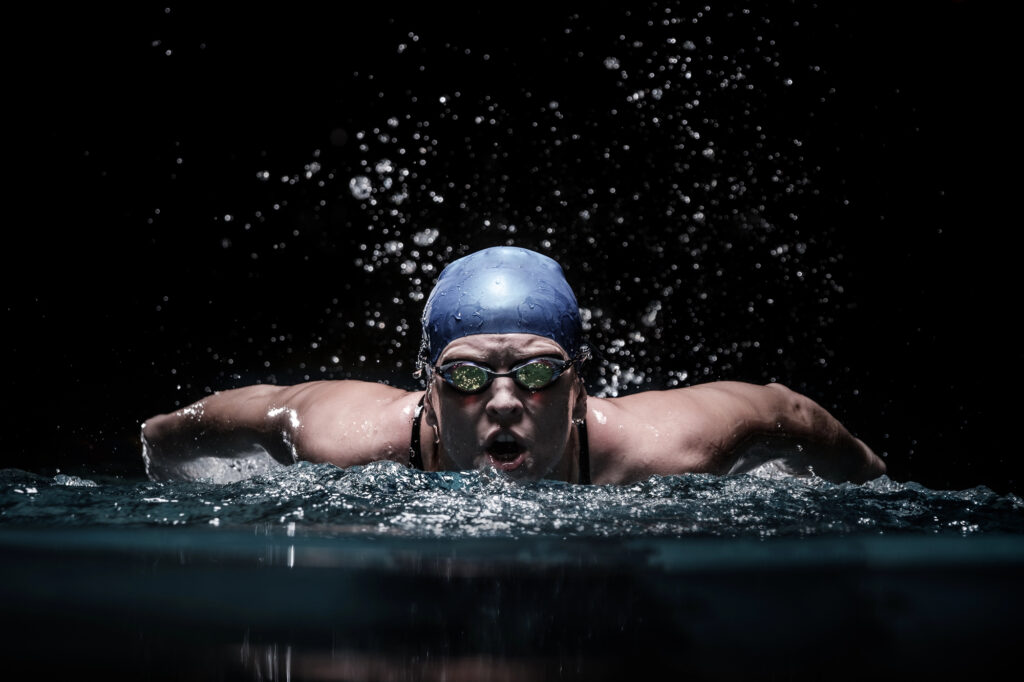
Common Mistakes and Correction Tips
Mastering the butterfly stroke requires attention to proper breathing, precise coordination, and effective fatigue management. Common errors in these areas can cost swimmers precious time and, potentially, medals.
Breathing Errors and Corrections
Common Mistake: Swimmers often disrupt their rhythm by lifting their heads too high to breathe, which increases drag and slows them down. Tip: They should aim to keep their chin near the surface, breathing quickly and forward to maintain a streamlined position. Read more about this breathing technique.
Coordination and Timing Issues
Common Mistake: Poor coordination between the kick and the arm pull often leads to inefficient strokes. Tip: Swimmers must ensure their kicks and pulls are synchronised to maximise propulsion; the pull phase should start just before the downbeat of the kick.
Physical and Mental Fatigue Management
Common Mistake: Swimmers sometimes fail to pace themselves, resulting in premature fatigue. Tip: Athletes should divide their race into segments, conserving energy in the early stages and gradually increasing intensity. This strategy allows swimmers to maintain a strong pace without succumbing to fatigue.
Preparation for Competition
As swimming competitions approach, competitors need to focus on tapering strategies, mental preparation, and concrete race day tactics to ensure optimal performance in the pool.
Tapering and Peaking for Races
Swimmers often reduce the volume and intensity of their training before a major race. This process, known as tapering, allows the body to recover and perform at its peak. For instance, in the weeks leading to the World Championships, swimmers might decrease their training load by 40-60% to arrive at the competition fully rested. It’s essential that during this period, athletes maintain their feel for the water with shortened, but high-quality swim sessions.
Mental and Psychological Readiness
Mental preparedness is as crucial as physical training. Swimmers employ various techniques such as visualisation of each race segment, positive self-talk, and relaxation exercises to bolster their confidence. They should focus on their own race strategy instead of getting distracted by competitors. The planning of these strategies typically involves reviewing past performances and setting realistic goals for the upcoming events.
Race Day Strategies
On the day of the race, having a set routine can significantly impact the swimmer’s performance. They should ensure a proper warm-up, which might include dynamic stretches and a mixture of aerobic swimming with race-pace efforts. Pre-race nutrition is tailored to provide sustained energy without causing discomfort. Additionally, swimmers concentrate on their race plan, including pacing and turning techniques, to avoid directionless swim workouts and maximise their performance in the 100m and 200m butterfly events.
Frequently Asked Questions
Breath control is crucial in swimming, particularly in butterfly events where the timing and frequency of breaths can significantly affect performance. This section answers common questions about breathing patterns for the 100-metre and 200-metre butterfly races.
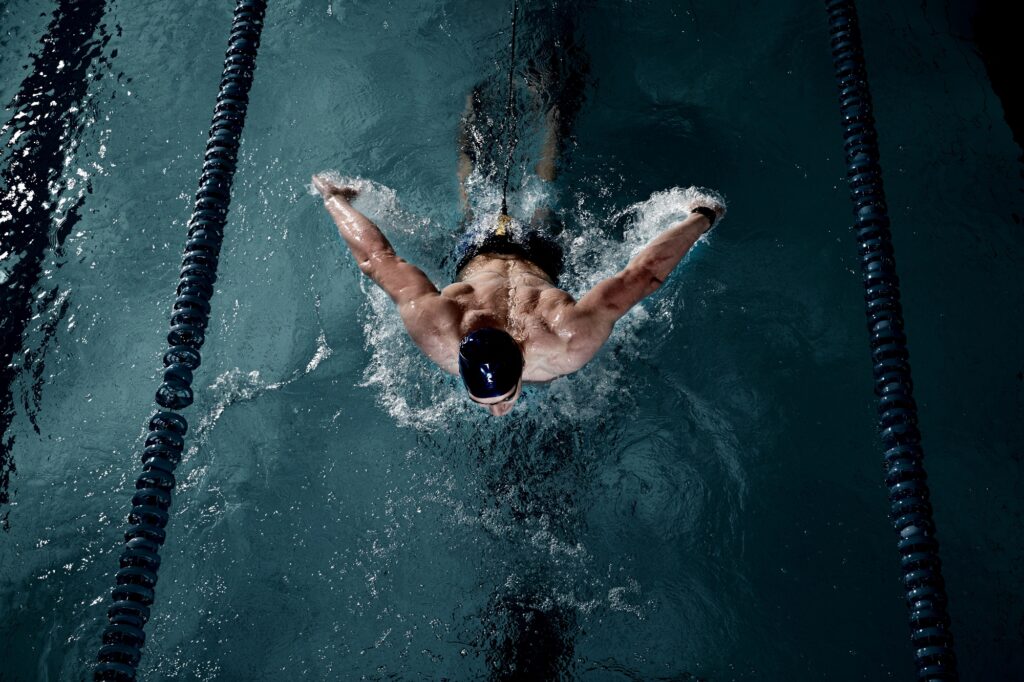
How often should a swimmer breathe during a 100-metre butterfly race?
In the 100-metre butterfly, swimmers tend to breathe every one to two strokes to maintain a high oxygen supply without disrupting the stroke rhythm.
What is an effective breathing strategy for the 200-metre butterfly?
For the longer 200-metre butterfly, a swimmer may adopt a breathing pattern of every two to three strokes, balancing the need for oxygen with the potential for increased drag.
Can breath control impact performance in butterfly swimming events?
Yes, breath control can profoundly impact performance. Proper technique ensures that swimmers maintain streamline position and minimise resistance while breathing.
What are common breathing techniques used by elite swimmers in butterfly races?
Elite swimmers in butterfly races often use sideline or front breath techniques, keeping their heads low to the water to maintain speed and reduce drag.
How does the breathing pattern in butterfly races differ from freestyle?
Unlike freestyle where breathing patterns can be more varied, in butterfly the stroke’s undulating motion dictates more rhythmic and well-timed breaths, usually synchronised with arm strokes.
What are the benefits of fewer breaths in butterfly sprints?
Fewer breaths in butterfly sprints can lead to a reduction in frontal drag and allow for a more consistent and faster stroke rate, which is crucial in high-speed races.

